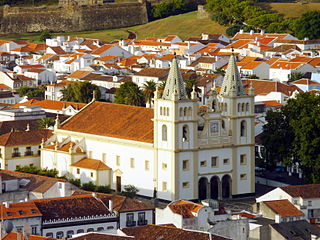
Namibe Province is a province of Angola. Under Portuguese rule it was the Moçâmedes District. It has an area of 57,091 km2 and had a 2014 census population of 495,326. The port and city of Moçâmedes is the capital of the province with a population of 250,000 in 2014. Iona National Park lies within the province.

The Diocese of Angra is a Latin Church diocese of the Catholic church in the Portuguese archipelago of the Azores. The see is located in Angra do Heroísmo, in the Terceira island. The current Ordinary is Armando Esteves Domingues.
Doce Tentação is a Portuguese telenovela that started airing on TVI on 8 January 2012 and stopped broadcasting on March 9, 2013. This telenovela was authored by Sandra Santos, from Casa da Criação, a group of soap opera/series authors of Plural Entertainment. The slogan of this telenovela is "Love that bears fruit, sows envy!". The protagonists are Mariana Monteiro, Diogo Amaral, Pedro Barroso and Sofia Ribeiro.
Events in the year 1995 in Portugal.

Prazeres Cemetery is one of the largest cemeteries in Lisbon, Portugal; it is located in the freguesia of Estrela, in western Lisbon. It is considered to be one of the most beautiful and famous cemeteries in the world. It is home to the Mausoleum of the Dukes of Palmela, the largest mausoleum in Europe.

Events in the year 1979 in Brazil.

Presença - Folha de Arte e Crítica was a Portuguese magazine published in Coimbra from 10 March 1927 until 1940, producing a total of 54 issues during its existence.

The Constituent Cortes of 1820, formal title The General and Extraordinary Cortes of the Portuguese Nation, also frequently known as the Sovereign Congress or the Cortes Constituintes Vintistas, was the first modern Portuguese parliament. Created after the Liberal Revolution of 1820 to prepare a constitution for Portugal and its overseas territories, it used a different system from the traditional General Cortes for choosing representatives, and the three traditional feudal estates no longer sat separately. The Cortes sat between January 24, 1821 and November 4, 1822 at the Palácio das Necessidades in Lisbon. The work of the Constitutional Cortes culminated in the approval of the Portuguese Constitution of 1822.